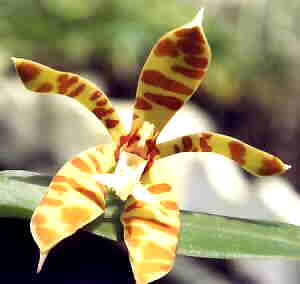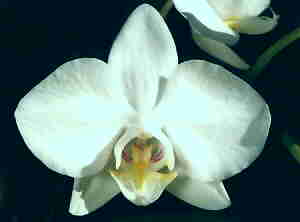BP SPECIES NEWSLETTER September 2001
July00
Aug
Sept
Oct
Nov
Dec
Jan01
Feb
Mar
April
May
June
July
August
Photos in this issue: Phalaenopsis
aphrodite (above), Trichoglottis fasciata, Dendrobium Sepik Blue
(ostrinoglossum, lasianthera), Captain Blood.
Do you know any orchid growers who may like to receive this newsletter?
Why not forward this email to them now!
Items in this newsletter may be reproduced provided source
acknowledged.
We commend "Orchids Online Web
Design" for the excellent work on our web site and this
Newsletter.
For information or prices click
here or email Steve at steve@orchidsonline.com........
A. What's New in flask.
Aerides virens alba 4N. Recently germinated is seed from a sib cross between two waxy white albas.
The species is a small growing form of Aerides odoratum, considered to be a tetraploid, and has been known as
Aerides virens.
It differs from A. odoratum in the smaller, more compact plant, the flowers are waxy, white
with the prominent forward curving horn like spur green. Fragrant.
Best grown in a small basket in an open media, a bit more shade than most vandaceous plants, and a well
ventilated spot.
TOP
B. What's ready to replate NOW.
Phalaenopsis aphrodite. A large pure white flower, with some red and yellow markings in the lip. The flowers
are well shaped, long lived and flower early Spring. Philippines.
Phalaenopsis formosanus. This is the species from Taiwan, Formosa, and is another very well shaped pure
white, with a touch of yellow deep in the lip.
It could well be a tetraploid form of its close cousin, P. aphrodite,
and has round, well filled in flowers of heavy substance.
Phalaenopsis amabilis grandiflora. The greatgrandaddy of the modern white hybrids. Large pure white, one of
the sib cross parents was particularly large and well shaped with overlapping petals and sepals. Flowers long
lasting, a Philippines species.
The large green leafed Phalaenopsis species require a good size shallow container, basket or pot. A media that
will drain well, shade and excellent air movement.
Plants should be kept slightly drier in the cooler months, with
watering early in the day to allow plants to dry off before nightfall. Small plants and seedlings out of flask
respond well in a 1:1 mix of shredded isolite and spaghnam moss.
TOP
C. What's new in Plants.

 Epidendrum cochleatum, a many named species, is best know as the
Cockle Shell Orchid. The quite large flowers have slightly twisted green to
green yellow sepals and petals, with the shell like lip uppermost, marked
almost black purple.
Epidendrum cochleatum, a many named species, is best know as the
Cockle Shell Orchid. The quite large flowers have slightly twisted green to
green yellow sepals and petals, with the shell like lip uppermost, marked
almost black purple.
A very fragrant species, best grown in a small pot or
basket in a well drained media that will also stay damp but not wet.
Flowering size plants are currently growing well in a mix of shredded
isolite and spaghnam moss.
Zygopetalum grandiflorum also known as Mendonsella grandiflora
and Galeottia grandiflora, is a very showy species with large green to
yellow green flowers striped red brown. The large lip is white, marked
redbrown, toothed maginally and very complex.
Best grown as for Zygopetalum with a pot of well drained media and a drier rest after the
new growths have matured.
Seedlings are growing well in our mix of isolite and shredded spaghnam moss.
Trichoglottis fasciata. A climbing species, requires a small pot or basket
with something to clamber up. An old fence paling, hung on the side of the orchid house will do.
Maximum sunlight, lots of water and fertiliser when growing, and the flowers will fill the orchidhouse with their fragrance.
Flowering size plants are growing robustly, waiting for a repot and something to clamber up. Photo above left.
TOP
D. Captain Blood's
Sepik Blue Dendrobium.

 "Would you have a plant of the Sepik Blue
orchid? ", a request from Susan Connor. A typical enquiry,
until she said she would like one because her father had
discovered it in New Guinea, and her maiden name was
Blood.
"Would you have a plant of the Sepik Blue
orchid? ", a request from Susan Connor. A typical enquiry,
until she said she would like one because her father had
discovered it in New Guinea, and her maiden name was
Blood.
Yes, we grow this species in flask from seed. It is a
warm growing Ceretobe Dendrobium from a wet and hot
part of the world, the Sepik River of North West New
Guinea.
A rampant grower, it requires a well drained shallow
pot or basket, with a rich media that will also drain well
but retain moisture, to stay just damp but not wet.
Maximum sunlight, even to slight leaf burn, will ensure
flowering, and ofcourse a warm place if you do not live in
the wet tropics.
When the plant is in active growth, a lot of fertiliser will
be of benefit. While the plant can grow to metres high, a
small pot with a bit of excess sunlight tends to keep the canes managable.
On replying to Susan, I asked if she knew the details of her fathers
discovery.

 Her reply; My fathers full name was Neptune Newcombe Beresford Lloyd Blood,
and he is credited with the discovery of the Sepik Blue Dendrobium
ostrinoglossum ( Dend lasianthera), described and named by Reverend
H.M.R.Rupp.
Her reply; My fathers full name was Neptune Newcombe Beresford Lloyd Blood,
and he is credited with the discovery of the Sepik Blue Dendrobium
ostrinoglossum ( Dend lasianthera), described and named by Reverend
H.M.R.Rupp.
All I know is that he most probably found it, when saving WW11 pilots
that were downed in the Sepik Area, as he was a Captain in the Australin Army,
but since he had intimate knowledge of New Guinea, he usually found them and
lead them to safety .....or carried them, one was a trek of some 60 odd
days....with no food and only he and his "police boy".
Dad discovered a Bird of Paradise,which was named after him, a
very 'ugly' bird as I said to Dad, why couldn't you find something outstandingly
beautiful??......“because they are garish and everyone sees them, I look behind
the scenes and find the hidden beauty, and the ones everybody tends to
overlook or forget“.
He sent many hundreds of specimen to the Sydney Museum, which
one notable author/naturalist has made good work for himself with Dad's
work.....and of course with all the inhabitants from New Guinea at Taronga
Park Zoo in Sydney.....also in Sweden ....and Singapore......
My Father was a very private man, and did not think that anything he did was of any importance to
the grand scheme of things.....and so I didn't get a chance to find out and document any and all of his exploits,
both pre war and post war.......and all the 40 odd years he spent in New Guinea.
He came to New Guinea and served as a Superintendant of Police, then when war broke out, he
joined the Australia Army. When the war was over, he became a Patrol Officer for a short while, but when Sir
Edward Hallstrom offered him a job to start the first Experimental Sheep Farm in the Highlands, he took it so
he could concentrate on that and his need to be a Naturalist.
After that,instead of going back to being a Patrol Officer, he decided to become a Agricultural officer
more in keeping with love of the plant Kingdom.....
You would have loved to see his Orchid House.....and his freshwater aquariums. and saltwater
aquariums, and his birds and his animals and butterflies, and when we were in the Highlands of New Guinea, he
had 20 acres of English Country Gardens.....which were truly a sight to see.

 So here is another species orchid with special
significance for a grower, and its history surely of interest
to any species grower.
So here is another species orchid with special
significance for a grower, and its history surely of interest
to any species grower.
May the seedlings blossom and always remind you of Captain Blood.
(The bird of paradise is Epimachus bloodi, a subspecies of E. meyeri, Central Highlands Brown Sicklebill, a large dark brown bird with a long curved bill.)
For more photos go to our photos pages
DID YOU KNOW.
Recent discoveries such as Paphiopedilum helenae and
Paphiopedilum vietnamense are CITES Class 1
endangered species.
The Vietnam Government has indicated that there has been no LEGAL export of these species nor is there any current artifical propagation of
these species.
So these new species are totally protected and the CITES provisions apply to both plants and FLASKS of the
species and their hybrids.
If Vietnam has not allowed the export of these species, then stock held is currently classified as not being
artificially propagated and illegally collected.
A full report can be found in the American Orchid Society Magazine "Orchids" July 2001.
TOP
E. Humour.
Once upon a time there was a shepherd looking after his sheep on the edge of
a deserted road.
Suddenly a brand new Porsche screeches to a halt. The driver, a man
dressed in an Armani suit, Cerutti shoes, Ray Ban sunglasses, TAG-Heuer
wrist-watch and Pierre Cardin tie gets out and asks the shepherd, "If I can
tell how many sheep you have, will you give me one of them?"
The shepherd looks at the young man, then looks at the grazing sheep and
replies, "Okay".
The young man parks the car, connects his lap-top to the mobile fax, enters
a NASA website, scans the ground using his GPS, opens a data base and 60
Excel tables filled with logarithms and pivot tables, then prints out a 150
page report on his high-tech mini-printer. He turns to the shepherd and
says, "You have exactly 1586 sheep here".
The shepherd answers, "That is correct, you can have your sheep."
The young man takes an animal and puts in the back of his Porsche.
The shepherd looks at him and asks, "If I guess your profession, will you
return the animal to me?"
The young man answers, "Yes why not?"
The shepherd says, "You are a consultant."
How did you know?" asks the
young man.
"Very simple" answers the shepherd. "First, you came here without being
called.
Second, you charged a fee to tell me something I already knew.
Third, you don't understand anything about my business.
Now can I have my dog back?"
For those not following Australian politics, the Government has come in for some critisism over spending.
A recent political report started by saying, " we know what they are going to do with the money, we just dont
know which wall they are doing it against."
Another report started " If John Howard ( Prime Minister) and John Anderson ( Deputy) can whip their parties
into line before the next election, they could get a job herding cats."
Ever herd a cat??
TOP
|




 Her reply; My fathers full name was Neptune Newcombe Beresford Lloyd Blood,
and he is credited with the discovery of the Sepik Blue Dendrobium
ostrinoglossum ( Dend lasianthera), described and named by Reverend
H.M.R.Rupp.
Her reply; My fathers full name was Neptune Newcombe Beresford Lloyd Blood,
and he is credited with the discovery of the Sepik Blue Dendrobium
ostrinoglossum ( Dend lasianthera), described and named by Reverend
H.M.R.Rupp.
 So here is another species orchid with special
significance for a grower, and its history surely of interest
to any species grower.
So here is another species orchid with special
significance for a grower, and its history surely of interest
to any species grower.